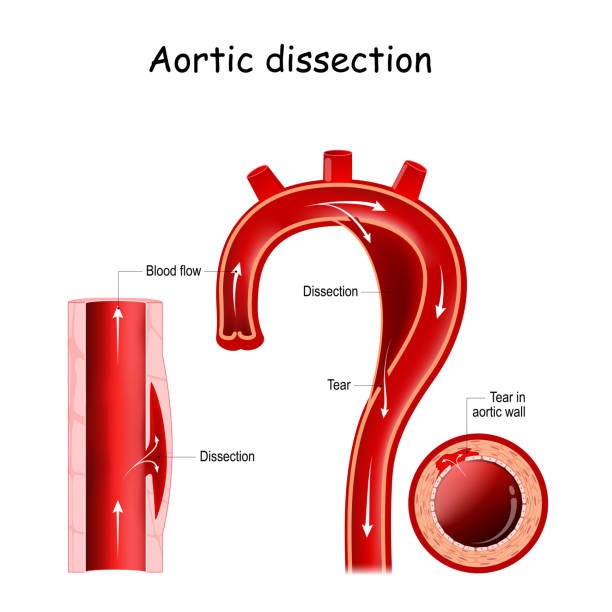
Be Careful With Severe Chest Pain! Analyze the Causes, Signs and Symptoms of Aortic Dissection, and Learn 4 Effective Ways to Prevent It
In recent years, aortic dissection has become a trend among younger people. Many young people have died due to aortic dissection. Therefore, young people should pay more attention to the cardiovascular health of themselves and their relatives and friends to avoid aortic dissection.
What exactly is aortic dissection? In addition to chest pain, what are the other symptoms? This article will explain to you the causes and treatment methods of aortic dissection, help you determine the signs of aortic dissection, and grasp the critical opportunity to seek medical treatment.
Why does aortic dissection occur? Aorta structure and function description
Before understanding what aortic dissection is, we must first talk about the human blood circulation system. The blood circulation system starts from the heart. After contraction, the oxygenated blood travels through the ascending aorta, aortic arch, and descending aorta located in the chest. After passing through the abdominal cavity, it is divided into two tributaries to the lower limbs, where the blood transportation is completed.
The aorta is the largest arterial blood vessel in the human body. Its structure consists of “three layers of connective tissue” consisting of inner, middle and outer layers. Under normal conditions, the inner wall of the aorta should remain smooth and elastic to withstand the pressure of blood flow. However, risk factors such as high blood pressure, hyperlipidemia, and smoking can cause inflammation of the blood vessel wall, causing the blood vessel wall to lose elasticity and harden, which is the so-called “atherosclerosis.” Once the plaque ruptures, it is likely to cause aortic dissection or myocardial infarction. Symptoms of acute heart disease such as infarction.

Causes of aortic dissection
The aorta is responsible for transporting blood throughout the body to maintain physiological functions. Aortic dissection means that the inner layer of the artery is ruptured, and the blood flow will flow to the middle and outer layers, tearing the aorta into two “false lumen” and “true lumen” Chamber.
The false cavity will compress the true cavity, preventing blood from being supplied to the whole body, causing ischemia. In addition, there is no complete connective tissue around the false cavity, which can easily rupture and cause massive bleeding, leading to shock, cerebral ischemia, and necrosis of the lower limbs. When aortic dissection occurs, the golden treatment time must be grasped. Every hour of delay increases the mortality rate by 1%.
Signs and symptoms of aortic dissection: Be careful if you experience severe chest pain!
Aortic dissection occurs quickly, fiercely and dangerously. The most typical symptom is severe, knife-like and unrelieved chest pain. Sometimes the pain will be transferred from the chest to the upper back, neck and shoulders. In addition to chest pain, patients with aortic dissection may also experience the following symptoms:
- Hypertension:
60% of patients will have symptoms of hypertension. - Pericardial tamponade:
Fluid accumulates in the pericardium and prevents the heart from beating. - Stroke, myocardial infarction, shock:
Blood vessels are blocked due to blood vessel dissection, resulting in a lack of blood supply to the organs and gradual loss of normal functions.
8 major risk factors for aortic dissection
In the past, aortic dissection was mostly thought to occur in the elderly. However, with the changes in modern people’s work and eating habits, aortic dissection has become a trend among younger people. The following are the 8 major risk factors for aortic dissection:
- Hypertension
- Hyperlipidemia
- High blood sugar
- Smoking or drinking alcohol for a long time
- Life is stressful
- Lack of exercise
- Long-term unbalanced diet
- Congenital marfan syndrome
Aortic dissection is divided into two types: A and B. The treatment must be clarified first.
Patients with aortic dissection require emergency treatment. Treatment can be divided into medical drugs and surgical treatment. However, there are still two types of aortic dissection, which should be clarified before formulating a treatment policy:
Type A aortic dissection
Type A aortic dissection is a dissection phenomenon that occurs in and extends from the ascending aorta. According to clinical statistics, about 50 to 60% of patients with aortic dissection have type A dissection.
Because the false lumen formed by type A aortic dissection can easily leak out a large amount of blood, causing “pericardial tamponade” and causing the heart to stop beating, it is the more dangerous type of aortic dissection, and the patient should be immediately arranged for surgical rescue. Depending on the condition, doctors will block the gap in the aortic dissection in order to perform artificial blood vessel replacement or repair the aortic valve.
Type B aortic dissection
If there is no dissection of the ascending aorta in a patient with aortic dissection, it is classified as type B aortic dissection. Type B aortic dissection is more likely to occur in the elderly. When there are no complications, drug treatment is usually the main treatment. The purpose is to control the patient’s blood pressure and relieve pain. It is also combined with dietary and lifestyle adjustments, and regular tracking of the aorta. Health status.
However, if patients with type B aortic dissection cause hemothorax due to false lumen rupture, or the descending aorta may be compressed to block blood flow, it may damage the functions of the gastrointestinal tract, liver, brain or kidneys. Surgical treatment is required to seal the tear in the aorta with a stent to prevent blood from flowing into the crack.

4 ways to prevent aortic dissection
It is not difficult to prevent aortic dissection. Developing the following four daily habits will effectively keep you away from the threat of aortic dissection:
- Regularly measure and keep blood pressure stable:
High blood pressure is the main cause of aortic dissection. You should develop the habit of measuring blood pressure at home with a regular sphygmomanometer to keep track of blood pressure changes so that when abnormal blood pressure is detected, you can seek medical attention as soon as possible to reduce the risk of blood pressure abnormalities. Risk of other cardiovascular diseases. - Healthy diet with less oil and salt:
It is recommended to cook by yourself and choose a diet high in fiber, less in oil and less in sugar, which will help to maintain healthy cholesterol and triglyceride levels. If you must eat out, try to avoid dishes that are overly flavorful, have too many additives, or are fried. - Develop exercise habits:
It is recommended to exercise for 30 minutes every day. Developing regular exercise habits can help control weight, promote metabolism and increase the concentration of high-density cholesterol (HDL, good cholesterol), which is beneficial to cardiovascular health. - Stay away from tobacco and alcohol:
The nicotine in cigarettes not only stimulates the sympathetic nerves and raises blood pressure, but also promotes the deposition of cholesterol on the inner walls of arteries, leading to arteriosclerosis. Excessive drinking can lead to elevated blood pressure and triglycerides, so it is strongly recommended You should drink alcohol in moderation and quit smoking immediately to protect your cardiovascular health and the health of your relatives and friends.












